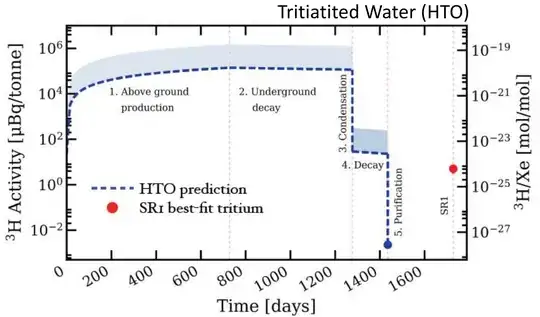With higher statistics, XENONnT and LZ will be able to recognize a potential tritium contamination by its energy spectrum and discriminate it from other explanations.
For fairness, one should stress that this excess showed up in their background that is of little concern to their main science target, which are nuclear recoils from dark matter (or neutrinos). Tritium was previously simply not considered in these xenon-based experiments. You can look through the various simulation-based proposals... for XENON1T, there's no mention of tritium at all, and from the LZ technical design report comes this gem:
Activation of the Xe itself during storage or transport generates several radionuclides, some of which are important, especially in the first few months of operation. Tritium [...] was previously a concern; however, this is effectively removed through purification during operation.
So indeed tritium was not expected. Indeed the required contamination of tritium is tiny, as the OP correctly says, about 3 atoms of tritium per kg of xenon. This is many, many orders of magnitude below any other method, in particular accelerator mass spectroscopy or other techniques typically used in the screening of low-background detector materials.
Tritium hypothesis is however disfavored as an explanation. Here's the details on that reasoning from a recent talk at a conference (pdf). Tritium is known to be produced in cosmic activation. But these detectors constantly purify their xenon, and that purification loop also removes tritium. XENON models this and expects tritium from cosmogenic activation to be negligible, here's the plot from that talk:

The observed excess, if explained by those 3 atoms of tritium per kg of xenon, is two orders of magnitude larger than what this model can explain.
Alternatively, they consider tritium from tritiated water. Typically, the HTO:H2O concentration (or HT:H2 concentration) is about 10-7 mol/mol, which would imply a water contamination in the xenon of some 100 parts per billion. That in turn is ruled out by their measurements of the (high) xenon light yield, which implies a water contamination of less than 1 part per billion.
So how can tritium still explain this excess? Perhaps from some TH reservoir in the materials of the detector? That would be somehow weird though, not sure how that would work. But I think that's the whole point: at this stage, there simply isn't any good explanation of the XENON1T excess at all. New Physics explanations (solar axions, neutrino magnetic moments, etc) are in tension with other constraints; Tritium is at odds with the above discussion; and statistics, well, at 3 sigma that always could be, but the trial factor in direct dark matter detection is nowhere as large as in typical collider experiments.
The good thing is that we won't have to wait very long. Both the XENONnT and LZ detectors are larger, both have a lower expected background, and both are being commissioned at the time of writing (summer 2021). With a few months of good background data, either of these experiments can measure the low-energy spectrum, and disentangle various explanations based on the shape of the measured energy spectrum. That said, and answering your actual question literally: there very much still is the possibility that XENONnT and LZ will see a contamination from tritium in their electronic recoil background; it is not removed.
